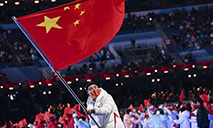Feature: Five decades later, what can be learned from Nixon's historic visit to China?
WASHINGTON, Feb. 20 (Xinhua) -- Fifty years ago, Richard Nixon became the first U.S. president to visit the People's Republic of China since its founding in 1949.
"The week that changed the world" melted the ice of estrangement between China and the United States and concluded with the Shanghai Communique, establishing principles for the development of bilateral relations.
The groundbreaking trip, according to its participants and scholars on China-U.S. relations speaking exclusively to Xinhua, is one of the most significant events in world history and has carried lessons for today on how to steer the frayed bilateral ties back on the right track.
HISTORIC VISIT
On Feb. 21, 1972, Nixon arrived in Beijing after months of negotiations and planning between the two sides. Exiting Air Force One and arriving at the bottom steps of the ramp, Nixon strode forward and eagerly extended his hand to then-Chinese Premier Zhou Enlai.
"Your handshake came over the vastest ocean in the world -- twenty-five years of no communication," Zhou told Nixon during the drive into the city. In his autobiography initially published in 1978, Nixon wrote that "when our hands met, one era ended and another began."
Within an hour or two of the U.S. delegation's arrival at the guest house, "to our surprise" Zhou came back and told Nixon's national security advisor Henry Kissinger that Chairman Mao Zedong "wanted to see the president," Winston Lord, then a Kissinger aide who went on to become the U.S. ambassador to China 13 years later, told Xinhua.
The summit lasted about an hour, in which Mao "basically kept his answers very brief," speaking one or two sentences at a time, according to Lord, one of only two American officials -- the other being Kissinger -- accompanying Nixon at the scene. In contrast, the visiting U.S. president "kept trying to engage him in depth on issues" like the Soviet Union and Japan, as well as the Taiwan question.
"At first we were somewhat puzzled and even a little bit disappointed because there wasn't more substantive exchange, but as we reflected on it and as we went through the next few days of talks with Zhou Enlai we realized that the chairman had skillfully with broad strokes given the outlines of the Chinese position, a framework from which Zhou Enlai could operate in detail," Lord said. "What seemed to be random, overly brief remarks by the chairman turned out to be quite skillful tour de force."
On his fourth day in China, Nixon left the meeting room and ventured out to see some of the most famous Chinese sights, including the Badaling section of the Great Wall, a magnificent ancient series of walls and fortifications in northern China totaling more than 21,000 kms (about 13,000 miles) in length.
After admiring the centuries-old structure, Nixon famously told reporters traveling with him that "I think that you would have to conclude that this is a great wall and it had to be built by a great people" and that "it is a certain symbol of what China in the past has been and of what China in the future can become."
SHANGHAI COMMUNIQUE
During Nixon's stay in China, Chinese and U.S. officials conducted talks at multiple levels on international affairs, regional hotspot issues and bilateral trade. On Feb. 28, the two countries issued the epoch-making Shanghai Communique before Nixon departed from Shanghai, opening a new chapter in China-U.S. relations.
Nixon's lead interpreter Chas Freeman told Xinhua that he drafted "a few small parts of the communique with trade and cultural exchange," adding, "my only involvement in the actual negotiation of the processing of the communique in China was to read the final documents in English and Chinese, where I discovered that the Chinese interpreters had been scrupulously fair."
"The most important innovation of that communique" was proposed by Zhou "that was the long recitation of Sino-American differences" -- a very unusual diplomatic practice, underlined Freeman, also former deputy chief of mission at the U.S. Embassy in Beijing. "This was essential for both countries, for China and the United States to reassure our friends that we were not betraying them or dealing behind their backs."
In the historical document, China and the United States outlined policy positions on various issues before stating their consensus, including "progress toward the normalization of relations between China and the United States is in the interests of all countries."
On the Taiwan question, China reiterated the one-China principle. At the same time, the United States declared it "acknowledges that all Chinese on either side of the Taiwan Strait maintain there is but one China and that Taiwan is a part of China" and reaffirmed "its interest in a peaceful settlement of the Taiwan question by the Chinese themselves."
"It was an unprecedented approach and it is amazing that 50 years later this communique is still remembered and invoked as one of the guidelines for bilateral policy, most communiques disappear without a trace within days," Lord, a drafter of the Shanghai Communique, observed. "So the Chinese foresight on this was well carried out and it was a very effective way to begin our relationship."
Summarizing the visit, Lord said the participants were "extremely excited and obviously this did turn out to be one of the three or four most fundamental geopolitical moves in the last half of the 20th century." Freeman described the visit as "obviously an enormously important moment in world history" and "an enormous success diplomatically for both countries."
The United States and China had a "turbulent relationship" of "ups and downs for a long time," Freeman said. "We found each other in pursuit of common interests."
LESSONS FOR TODAY
The international landscape has undergone significant change over the past several decades. China-U.S. relations have evolved from strategic cooperation to post-Cold War cooperation and competition before an increasingly ideological United States openly moved to contain China in recent years.
Despite the fraying relationship, both China and the United States have scheduled commemorative activities to mark the 50th anniversary of Nixon's visit to China and the issuance of the Shanghai Communique this month.
Nixon's visit and the communique offer "important lessons for us today and that it is possible to set aside ideological differences and in differences of interests and pursue cooperation, notwithstanding those differences," said Freeman, while calling for efforts to "rediscover the merits of putting cooperation first and competition second."
"That is to say, of course, there are some things we disagree about. Of course, there are some ways in which we are competing with each other, but that should not cause us to lose sight of the important issues that we have in common," he noted.
Nixon's visit and the communique carry "some permanent lessons for international diplomacy" and "the key thing is to recognize the needs and the basic interest on the other side," Lord said.
"It doesn't always have to be expressed as starkly as the Shanghai Communique in terms of illustrating differences, but the basic principle of knowing each other's needs and being willing to postpone issues and manage them when you can't solve them immediately, make sure they don't get out of hand or get into conflict, and then focus where you could cooperate," the foreign policy veteran suggested.
"You won't always need the courage and the strategic vision of the two sides that you had then, but it's always useful for leaders to take the big picture and not just tactical advantage and to be willing to lead public opinion, not always be subserving to it," he added.
Arne Westad, Elihu Professor of History and Global Affairs at Yale University, echoed Lord and told Xinhua that it is important to "try to work with each other in order to understand better what the strategic priorities of the other side really are" in order to avoid strategic misunderstandings in terms of great power relations.
"Though the China-U.S. relations is currently not in a good position, the scale of the development of their ties and the scope of bilateral exchanges are far greater than 50 years ago," Niu Jun, professor at the School of International Relations, Peking University, told Xinhua. "Opportunities for improvement in China-U.S. relations always exist."
Photos
Related Stories
- How Xi's remarks guide healthy China-U.S. ties
- U.S. report on China's WTO compliance lacks legal, factual basis: commerce ministry
- China opposes U.S. releasing irresponsible IPR report: commerce ministry
- U.S. labeling China "non-market" entirely false: ministry
- U.S. should address systemic racism: Chinese FM spokesperson
Copyright © 2022 People's Daily Online. All Rights Reserved.










